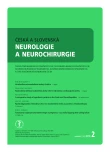Rapid diagnostics of chemokine CXCL13 in the cerebrospinal fluid of patients with neuroborreliosis
Authors:
D. Pícha; L. Moravcová; D. Smíšková
Authors‘ workplace:
Klinika infekčních nemocí 2. LF UK a Nemocnice Na Bulovce, Praha
Published in:
Cesk Slov Neurol N 2019; 82(2): 215-218
Category:
Short Communication
doi:
https://doi.org/10.14735/amcsnn2019215
Overview
Chemokine CXCL13 is a strong chemoattractant for leukocytes in the CSF. It has been proven that CSF CXCL13 concentration is substantially elevated in the early stage of Lyme neuroborreliosis (LNB). Its level is increased even before the specific antibodies are synthesized in this compartment. CXCL13 was proven to have high positive and negative diagnostic significance and this diagnostic attitude has not yet been included in a routine clinical diagnostic algorithm of LNB. Two methods of chemokineCXCL13 detection in CSF were tested in two groups of patients with clinical manifestations of LNB and other aseptic neuroinfections: 1. semiquantitative immunochromatic method ReaScan CXCL13 rapid test and 2. quantitative method CXCL13/ BLC/ BCA-1 Quantikine ELISA. A high concordance of the results of these tests was verified using Cohen coefficient kappa (P < 0.001). The ReaScan CXCL13 rapid test is easy to use and time-saving (20 min), therefore, it is suitable as an additional examination for routine early diagnostics of LNB. Proving CSF CXCL13 elevation enables quick antibiotic treatment, especially in cases where the local antibody synthesis has not been proven yet, which can be seen in the proposed diagnostic algorithm.
The authors declare they have no potential conflicts of interest concerning drugs, products, or services used in the study.
The Editorial Board declares that the manuscript met the ICMJE “uniform requirements” for biomedical papers.
脑脊液中趋化因子CXCL13的快速诊断
趋化因子CXCL13是脑脊液中白细胞的强趋化因子。已有研究证明,在莱姆病(LNB)早期,脑脊液CXCL13浓度明显升高。它的水平甚至在特定抗体在这个腔室合成之前就已经增加了。CXCL13被证实具有较高的阳性和阴性诊断意义,而这种诊断态度尚未被纳入LNB的常规临床诊断算法中。对两组临床表现为LNB及其他无菌性神经感染的患者进行CSF趋化因子CXCL13检测的两种方法:1。半定量免疫染色法可用于CXCL13快速检测和2。定量方法CXCL13/ BLC/ BCA-1定量ELISA法。用科恩系数kappa (P < 0.001)验证了这些试验结果的高度一致性。使用方便,节省时间(20分钟);因此,它适合作为LNB常规早期诊断的补充检查。证明CSF CXCL13升高能够快速抗生素治疗,特别是在尚未证实局部抗体合成的情况下,这可以从所提出的诊断算法中看出。
关键词:
莱姆病 - CXCL13趋化因子-诊断学
Keywords:
Lyme neuroborreliosis – CXCL13 chemokine
Sources
1. Koedel U, Fingerle V, Pfister HW. Lyme neuroborreliosis-epidemiology, diagnosis and management. Nat Rev Neurol 2015; 11(8): 446–456. doi: 10.1038/ nrneurol.2015.121.
2. Hammers-Berggren S, Hansen K, Lebech AM et al. Borrelia burgdorferi-specific intrathecal antibody production in neuroborreliosis: a folow-up study. Neurology 1993; 43(1): 169–175.
3. Mygland A, Ljøstad U, Fingerle V et al. EFNS guidelines on the diagnosis and management of European Lyme neuroborreliosis. Eur J Neurol 2010; 17(1): 8–16. doi: 10.1111/ j.1468-1331.2009.02862.x.
4. De Haas AH, van Weering HR, de Jong EK et al. Neuronal chemokines: versatile messengers in central nervous system cell interaction. Mol Neurobiol 2007; 36(2): 137-151. doi: 10.1007/ s12035-007-0036-8.
5. Ljøstad U, Mygland A. CSF B – lymphocyte chemoattractant (CXCL13) in the early diagnosis of acute Lyme neuroborreliosis. J Neurol 2008; 255(5): 732–737. doi: 10.1007/ s00415-008-0785-y.
6. Rupprecht TA, Pfister HW, Angele B et al. The chemokine CXCL13 (BLC): a putative diagnostic marker for neuroborreliosis. Neurology 2005; 65(3); 448–450. doi: 10.1212/ 01.wnl.0000171349.06645.79.
7. Hytönen J, Kortela E, Waris M et al. CXCL13 and neopterin concentrations in cerebrospinal fluid of patients with Lyme neuroborreliosis and other diseases that cause neuroinflammantion. J Neuroinflammation 2014; 11 : 103. doi: 10. 1186/ 1742-2094-11-103.
8. Pícha D, Moravcová L, Smíšková D. Prospective study on the chemokine CXCL13 in neuroborreliosis and other aseptic neuroinfections. J Neurol Sci 2016; 368 : 214–220. doi: 10.1016/ j.jns.2016.05.059.
9. Rubenstein JL, Wong VS, Kadoch C et al. CXCL13 plus interleukin 10 is highly specific for diagnosis of CNSLymphoma. Blood 2013; 121(23): 4740–4748. doi: 10.1182/ blood-2013-01-476333.
10. van Burgel ND, Bakels F, Kroes AC et al. Discriminating Lyme neuroborreliosis from other neuroinflammatory diseases by levels of CXCL13 in cerebrospinal fluid. J Clin Microbiol 2011; 49(5): 2027–2030. doi: 10.1128/ JCM.00084-11.
11. Schmidt C, Plate A, Angele B et al. A prospective study on the role of CXCL13 in Lyme neuroborreliosis. Neurology 2011; 76(12): 1051–1058. doi: 10.1212/ WNL.0b013e318211c39a.
12. Koedel U, Pfister HW. Lyme neuroborreliosis. Curr Opin Infect Dis 2017; 30(1): 101–107. doi: 10.1097/ QCO.0000000000000332.
13. Rupprecht TA, Manz KM, Fingerle V et al. Diagnostic value of cerebrospinal fluid CXCL13 for acute Lyme neuroborreliosis. A systematic review and meta-analysis. Clin Microbiol Infect 2018; 24(12): 1234–1240. doi: 10.1016/ j.cmi.2018.04.007.
Labels
Paediatric neurology Neurosurgery NeurologyArticle was published in
Czech and Slovak Neurology and Neurosurgery

2019 Issue 2
Most read in this issue
- Intradural extramedullary spinal cord tumors
- Rapid diagnostics of chemokine CXCL13 in the cerebrospinal fluid of patients with neuroborreliosis
- Genetics of neuromuscular diseases
- Multiple sclerosis and pregnancy from a gynecologist‘s perspective – as sisted reproduction options
